INSTITUT SUPERIEUR D'ANTHROPOLOGIE
INSTITUTE OF ANTHROPOLOGY
ONLINE COURSES / COURS A DISTANCE
SUMMER TERM : JULY 2014
REGISTER NOW
EGYPTE – 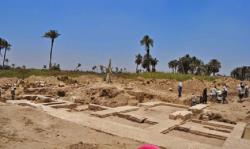
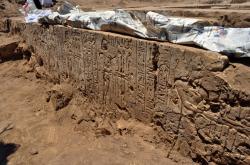 Gebel El-Nour - A yet unknown temple of Ptolemaic date has been brought to light by an Egyptian state archaeological mission according to a recent announcement by the Ministry of Antiquities. Made of limestone and probably dedicated to Isis, the temple had been commissioned by King Ptolemy II Philadelphus (284-246 BC) according to inscriptions on blocks recording the name of this king, which were unearthed in a certain part of the temple. This part, which was fully excavated, was divided into few rooms where pottery was also found. Ptolemy II is prominently portrayed also on the exterior of the eastern side of the temple, bearing offerings and followed by the figure of the Nile god Hapi. Commending on the finds, Minister of Antiquities Mohamed Ibrahim said that, ”more excavations has to be carried out to uncover more of the architectural elements of the temple soon”.
Gebel El-Nour - A yet unknown temple of Ptolemaic date has been brought to light by an Egyptian state archaeological mission according to a recent announcement by the Ministry of Antiquities. Made of limestone and probably dedicated to Isis, the temple had been commissioned by King Ptolemy II Philadelphus (284-246 BC) according to inscriptions on blocks recording the name of this king, which were unearthed in a certain part of the temple. This part, which was fully excavated, was divided into few rooms where pottery was also found. Ptolemy II is prominently portrayed also on the exterior of the eastern side of the temple, bearing offerings and followed by the figure of the Nile god Hapi. Commending on the finds, Minister of Antiquities Mohamed Ibrahim said that, ”more excavations has to be carried out to uncover more of the architectural elements of the temple soon”.
http://www.archaiologia.gr/en/blog/2014/05/20/ptolemaic-temple-found-in-gebel-el-nour/
ESPAGNE – 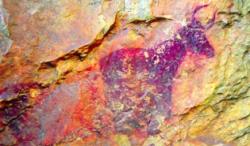 Vilafranca - In Eastern Spain archaeologists have discovered 12 prehistoric rock paintings.Town hall officials in the Valencian municipality of Vilafranca announced the finding today (Tuesday) but are keeping the exact location secret until all of the necessary security measures are in place. The paintings, which depict hunting scenes and are from around 7,000 years ago, are the most important find of their kind in the region for a number of years. Reportedly, the area is now being searched for more paintings. Security is an issue that certainly needs to be addressed. Just last month a UNESCO World Heritage listed 5,000-year-old rock painting was destroyed in Jaen. Vandals attempted to remove the cave-painting and damaged it beyond repair. Along Spain’s Mediterranean coast there are several hundred sites where prehistoric paintings have been found. According to UNESCO, these sites form the largest group in Europe.
Vilafranca - In Eastern Spain archaeologists have discovered 12 prehistoric rock paintings.Town hall officials in the Valencian municipality of Vilafranca announced the finding today (Tuesday) but are keeping the exact location secret until all of the necessary security measures are in place. The paintings, which depict hunting scenes and are from around 7,000 years ago, are the most important find of their kind in the region for a number of years. Reportedly, the area is now being searched for more paintings. Security is an issue that certainly needs to be addressed. Just last month a UNESCO World Heritage listed 5,000-year-old rock painting was destroyed in Jaen. Vandals attempted to remove the cave-painting and damaged it beyond repair. Along Spain’s Mediterranean coast there are several hundred sites where prehistoric paintings have been found. According to UNESCO, these sites form the largest group in Europe.
https://www.euroweeklynews.com/news/spanish-news/item/120654?
ROYAUME UNI – 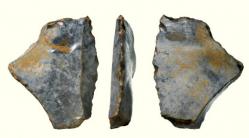 Londres - A group of archaeologists from the Museum of London Archaeology digging at the site of the U.S. Embassy in Vauxhall, South London, has discovered flint tools dating to the Paleolithic period (before 10,000 BC). London has a long and rich history, which is often attributed as having begun with the arrival of the Romans. The site of the new U.S. Embassy in Vauxhall was once a river consisting of smaller channels with sandy and gravelly islands in between. Some of the islands were large enough and dry enough for prehistoric people to settle on. The fertile, marshy banks provided access to rich food sources and were a perfect hunting ground for prehistoric communities. The flint tools found at the site could be one of the earliest objects found in London. “What we have found may be the earliest archaeological evidence currently known from London,” said team member Dr Kasia Olchowska. “It will be interesting to see how this evidence relates to other prehistoric structures on the nearby Thames foreshore.” “We hope to be able to reconstruct and have a better understanding of the prehistoric landscape of a much wider area than at present.” Other finds include a prehistoric fish trap, about 12 m long, and evidence for camp fires. Further analysis of the finds needs to be carried out to establish firm dates and learn more about their production and use.
Londres - A group of archaeologists from the Museum of London Archaeology digging at the site of the U.S. Embassy in Vauxhall, South London, has discovered flint tools dating to the Paleolithic period (before 10,000 BC). London has a long and rich history, which is often attributed as having begun with the arrival of the Romans. The site of the new U.S. Embassy in Vauxhall was once a river consisting of smaller channels with sandy and gravelly islands in between. Some of the islands were large enough and dry enough for prehistoric people to settle on. The fertile, marshy banks provided access to rich food sources and were a perfect hunting ground for prehistoric communities. The flint tools found at the site could be one of the earliest objects found in London. “What we have found may be the earliest archaeological evidence currently known from London,” said team member Dr Kasia Olchowska. “It will be interesting to see how this evidence relates to other prehistoric structures on the nearby Thames foreshore.” “We hope to be able to reconstruct and have a better understanding of the prehistoric landscape of a much wider area than at present.” Other finds include a prehistoric fish trap, about 12 m long, and evidence for camp fires. Further analysis of the finds needs to be carried out to establish firm dates and learn more about their production and use.
http://www.sci-news.com/archaeology/science-paleolithic-tools-us-embassy-london-01932.html
CHINE –  Chongqing - China's first underwater archaeological exploration vessel has begun testing in southwest China's Chongqing Municipality. The ship, owned by China's cultural heritage team, is berthed at the private port of Changhang Dongfeng Shipbuilding Corporation. The hull of the ship is white, emblazoned with "Chinese Archeology" both in Chinese and English. The 500-tonne, 56-meter vessel has a maximum displacement of 960 tonnes, and can carry a crew of 30, according to an official with the Chongqing culture and heritage commission. Underwater archaeology in China has made great strides since the 1980s and a number of professional institutions and teams work in the field. The lack of properly equipped vessels ships has long been a problem. This ship, designed by the 701 Research Institute of the China Shipbuilding Industry Corporation, will continue testing in Shanghai before sailing out to the Xisha Islands in the South China Sea to begin archaeology work.
Chongqing - China's first underwater archaeological exploration vessel has begun testing in southwest China's Chongqing Municipality. The ship, owned by China's cultural heritage team, is berthed at the private port of Changhang Dongfeng Shipbuilding Corporation. The hull of the ship is white, emblazoned with "Chinese Archeology" both in Chinese and English. The 500-tonne, 56-meter vessel has a maximum displacement of 960 tonnes, and can carry a crew of 30, according to an official with the Chongqing culture and heritage commission. Underwater archaeology in China has made great strides since the 1980s and a number of professional institutions and teams work in the field. The lack of properly equipped vessels ships has long been a problem. This ship, designed by the 701 Research Institute of the China Shipbuilding Industry Corporation, will continue testing in Shanghai before sailing out to the Xisha Islands in the South China Sea to begin archaeology work.
http://english.cntv.cn/2014/05/20/ARTI1400547007235987.shtml
ROYAUME UNI – 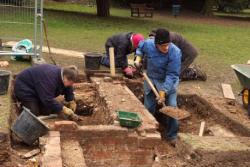 Marlow - The search for a legendary medieval hospital built by the Knights Templar will resume this weekend as archaeology enthusiasts get to work in a Marlow park.The history hunters made the discovery of a cellar dating back to around 1660 while looking for the remains of a farmhouse built a hundred years later.A hospital constructed by the knights after the medieval crusades in the 14th century is rumoured to lie somewhere in Marlow. And with no record of a building on the Rookery Park dig site from before 1770s, members hope they can start answer some of the burning questions raised by their dig last year. Society member Doug Courtney said: “We are trying to get further with this older building that no one was expecting to find. “We are trying to get dating information, what we have found we have dated approximately, but we want to find the rest of the cellar. “Unfortunately, the new cycle path in the park has destroyed much of the evidence. But it could be quite interesting bearing in mind the Knights Templar hospital that could be in the area. Wouldn’t it be great if we found it?”
Marlow - The search for a legendary medieval hospital built by the Knights Templar will resume this weekend as archaeology enthusiasts get to work in a Marlow park.The history hunters made the discovery of a cellar dating back to around 1660 while looking for the remains of a farmhouse built a hundred years later.A hospital constructed by the knights after the medieval crusades in the 14th century is rumoured to lie somewhere in Marlow. And with no record of a building on the Rookery Park dig site from before 1770s, members hope they can start answer some of the burning questions raised by their dig last year. Society member Doug Courtney said: “We are trying to get further with this older building that no one was expecting to find. “We are trying to get dating information, what we have found we have dated approximately, but we want to find the rest of the cellar. “Unfortunately, the new cycle path in the park has destroyed much of the evidence. But it could be quite interesting bearing in mind the Knights Templar hospital that could be in the area. Wouldn’t it be great if we found it?”
http://www.bucksfreepress.co.uk/news/11222738.Search_for_medieval_hospital_remains_continues_this_weekend/
ROYAUME UNI - Ridgeway - Excavations of Ridgeway Farm have thrown up the remnants of an Iron Age farming settlement more than 2,000 years old. During an initial survey of the site ahead of the construction phases, which began last year, Wessex Archaeology discovered evidence of a burial site, rubbish pits and a limestone quarry.A spokesman for Wessex Archaeology said in its report: “To the south-west of Ridgeway Farm, the fieldwork revealed a concentration of intercutting Early to Middle Iron Age rubbish pits containing deliberately deposited occupation debris including pottery and animal bone. “To the south, a second concentration of features which could relate to quarrying or tree clearance, were dated to the Romano-British period.“Extensive modern land-fill recorded in the north-west of the site comprised contaminated clay.“The area may have been quarried for limestone prior to the modern infilling.“Archaeological features in the south-west of the site define areas of Early to Middle Iron Age and Romano-British activity.“The character of the features and the range of artifacts recovered are of local significance.“Pottery fragments recovered from the topsoil overlying these features and from the topsoil in adjacent trenches were dated to the Romano-British and possibly Saxon period and are important in defining the extent of a proposed archaeological mitigation area.“The archaeological remains were encountered immediately below the topsoil and would be directly impacted by any future development.”
http://www.thisiswiltshire.co.uk/news/11223141.Iron_Age_settlement_found_on_Ridgeway/
ISRAËL - 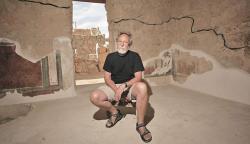 Masada - For 20 years, the frescoes that decorated the “Commandant’s Residence” (Beit Hamefaked) on top of Masada were stored away in a warehouse at the national park. This week, after a month’s work, a team headed by Italian expert renovator Prof. Maurizio Tagliapietra of the University of Verona and including employees of the Israel Parks and Nature Authority completed the restoration of another room on the top of the historic mountain. The frescoes, which were discovered during the extensive archaeological digs conducted by Yigal Yadin in the 1960s, were glued to new backings and put back in their original locations on the walls at the time. But as time passed the effects of the weather, the high salt content of the air and vandalism by visitors eventually led to the decision to remove them and put them into storage. The frescoes were in a structure on Masada without a roof, and it was decided that only after a proper roof was built would they be returned. “The frescoes are from the period of Herod,” said Tagliapietra. They are of geometric figures, with no human beings, and show no perspective, he said. The frescoes prove the room was the living quarters of commanders who were close to Herod and responsible for his personal security, as indicated by their proximity to the Northern Palace.This time his difficult work did not end with just reinstalling the frescoes. It also included teaching the Israeli staff various methods necessary to maintain the artwork. Each picture, which can be up to 1.5 meters by 0.5 meters, took over eight hours of work: emphasizing the pigments using paintbrushes and plaster made by mixing lime with sand, in order to get as close as possible to the original materials.
Masada - For 20 years, the frescoes that decorated the “Commandant’s Residence” (Beit Hamefaked) on top of Masada were stored away in a warehouse at the national park. This week, after a month’s work, a team headed by Italian expert renovator Prof. Maurizio Tagliapietra of the University of Verona and including employees of the Israel Parks and Nature Authority completed the restoration of another room on the top of the historic mountain. The frescoes, which were discovered during the extensive archaeological digs conducted by Yigal Yadin in the 1960s, were glued to new backings and put back in their original locations on the walls at the time. But as time passed the effects of the weather, the high salt content of the air and vandalism by visitors eventually led to the decision to remove them and put them into storage. The frescoes were in a structure on Masada without a roof, and it was decided that only after a proper roof was built would they be returned. “The frescoes are from the period of Herod,” said Tagliapietra. They are of geometric figures, with no human beings, and show no perspective, he said. The frescoes prove the room was the living quarters of commanders who were close to Herod and responsible for his personal security, as indicated by their proximity to the Northern Palace.This time his difficult work did not end with just reinstalling the frescoes. It also included teaching the Israeli staff various methods necessary to maintain the artwork. Each picture, which can be up to 1.5 meters by 0.5 meters, took over eight hours of work: emphasizing the pigments using paintbrushes and plaster made by mixing lime with sand, in order to get as close as possible to the original materials.
http://www.haaretz.com/archaeology/.premium-1.591649
INDE - Talkad - For those who think financial fraud or circulating fake currencies is a modern day phenomenon, an ancient Roman coin mould on display at the Department of Archaeology, Museums and Heritage in the city is a startling revelation. The Roman coin mould, which is being displayed for the first time since its excavation in 1993, indicates that fake coins were in circulation around 19 to 20 centuries ago. The terracotta mould is among the most important objects displayed at the exhibition, apart from terracotta figurines, iron objects, bronze dies, stone beads. M S Krishnamurthy, a retired professor of Archaeology who led the team that unearthed the mould, told Deccan Herald that it was a mould for Roman coins in circulation during the first century AD. “The coins probably were minted either during the period of Augustus or his son Tiberius,” he said. “In the area where we spotted the mould, a foundry with a crucible was also found. Considering this, it is possible that a person living in Talkad was minting duplicate coins of Romans,” he said. He added that it was one of the rare and unique moulds excavated in the State. Archaelogist Gowda N L said that the mould contained an inscription of Greek goddess Livia with words, ‘Maxim Pontis’. “The coins with the same inscriptions were in circulation around the country. Roman coins belonging to the first century AD have been found in various excavation sites around the country. However, such a terracotta mould has never been found elsewhere.” He added that the coins might have been minted at Talkad and circulated around the country. “It is possible that the value of Roman currency was more in India during the period, which might have led a few individuals at Talkad to indulge in minting fake coins,” he added.
Talkad - For those who think financial fraud or circulating fake currencies is a modern day phenomenon, an ancient Roman coin mould on display at the Department of Archaeology, Museums and Heritage in the city is a startling revelation. The Roman coin mould, which is being displayed for the first time since its excavation in 1993, indicates that fake coins were in circulation around 19 to 20 centuries ago. The terracotta mould is among the most important objects displayed at the exhibition, apart from terracotta figurines, iron objects, bronze dies, stone beads. M S Krishnamurthy, a retired professor of Archaeology who led the team that unearthed the mould, told Deccan Herald that it was a mould for Roman coins in circulation during the first century AD. “The coins probably were minted either during the period of Augustus or his son Tiberius,” he said. “In the area where we spotted the mould, a foundry with a crucible was also found. Considering this, it is possible that a person living in Talkad was minting duplicate coins of Romans,” he said. He added that it was one of the rare and unique moulds excavated in the State. Archaelogist Gowda N L said that the mould contained an inscription of Greek goddess Livia with words, ‘Maxim Pontis’. “The coins with the same inscriptions were in circulation around the country. Roman coins belonging to the first century AD have been found in various excavation sites around the country. However, such a terracotta mould has never been found elsewhere.” He added that the coins might have been minted at Talkad and circulated around the country. “It is possible that the value of Roman currency was more in India during the period, which might have led a few individuals at Talkad to indulge in minting fake coins,” he added.
http://www.deccanherald.com/content/408181/mould-minting-roman-coins-found.html
EGYPTE- 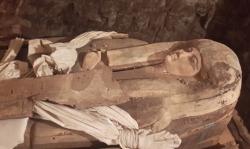 Saqqara - Three painted sarcophagi belonging to an Ancient Egyptian singer have been unearthed at SaqqaraDuring excavation works carried out in Bastet cemetery at the Saqqara necropolis just outside Cairo, French archaeologists stumbled upon three wooden sarcophagi belonging to Ta-Ekht, a singer in a sacred choir in the 18th dynasty period (1543–1292 BC). Mohamed Ibrahim, the antiquities minister, said that the sarcophagi were found inside each other. The outer sarcophagus is a little deteriorated while the middle and inner ones are well-preserved. Ibrahim told Ahram Online on Saturday that the sarcophagi were unearthed during excavation works at the tomb of the daughter of 18th dynasty pharaoh Akhenaten, Maya, who was known as Meritee Atun. Ali El-Asfar, head of the ancient Egyptian antiquities department at the ministry told Ahram Online that the sarcophagi depict the facial features of Ta-Ekht and are decorated with paintings of foliage. Some elements of Ta-Ekht's funerary collection were also found inside the middle sarcophagus, including two wooden headrests and a rectangular wooden box inlaid with ivory. The box contained a collection of beauty tools were found, including a spoon with a gazelle-shaped handle, two eye liner containers, a collection of faience beads, and a faience amulet in the famous “eye of Horus” shape. El-Asfar said that studies are now being conducted to find out why the singer’s sarcophagi were located inside Maya tomb.
Saqqara - Three painted sarcophagi belonging to an Ancient Egyptian singer have been unearthed at SaqqaraDuring excavation works carried out in Bastet cemetery at the Saqqara necropolis just outside Cairo, French archaeologists stumbled upon three wooden sarcophagi belonging to Ta-Ekht, a singer in a sacred choir in the 18th dynasty period (1543–1292 BC). Mohamed Ibrahim, the antiquities minister, said that the sarcophagi were found inside each other. The outer sarcophagus is a little deteriorated while the middle and inner ones are well-preserved. Ibrahim told Ahram Online on Saturday that the sarcophagi were unearthed during excavation works at the tomb of the daughter of 18th dynasty pharaoh Akhenaten, Maya, who was known as Meritee Atun. Ali El-Asfar, head of the ancient Egyptian antiquities department at the ministry told Ahram Online that the sarcophagi depict the facial features of Ta-Ekht and are decorated with paintings of foliage. Some elements of Ta-Ekht's funerary collection were also found inside the middle sarcophagus, including two wooden headrests and a rectangular wooden box inlaid with ivory. The box contained a collection of beauty tools were found, including a spoon with a gazelle-shaped handle, two eye liner containers, a collection of faience beads, and a faience amulet in the famous “eye of Horus” shape. El-Asfar said that studies are now being conducted to find out why the singer’s sarcophagi were located inside Maya tomb.
http://english.ahram.org.eg/NewsContent/9/40/101518/Heritage/Ancient-Egypt/Funeral-relics-of-pharaonic-singer-unearthed-at-Sa.aspx
PEROU – 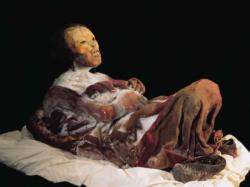 Juanita - Scientists are hoping to learn more about the origins of Peru’s famous “Mummy Juanita” through DNA testing using the stem cells stored in the subject’s umbilical cord. The mummy was found in 1995 by anthropologist Johan Reinhard in southern Peru. According to La Republica, Juanita was approximately 13 years old at the time of her death. She was apparently killed by a blow to the back of the head as part of an Inca human sacrifice ritual. Though some DNA analysis was performed shortly after the discovery of the mummy, scientists believe they may be able to use recent developments in technology to shed more light on Juanita’s story. El Comercio reports that investigators plan to use samples taken from the mummy’s umbilical cord in order to carry out their research. Jose Antonio Chavez, director of the Santuarios Andinos museum where Juanita is on display, told press that “Broadening the scientific studies of the stem cells in the umbilical cord of the Mummy Juanita will be opportune because it will allow us to obtain more information about the origin of the sacrificed adolescent and her family.”El Comercio reports that investigators also plan to examine the seeds and pollen found preserved with Juanita in order to learn more about the climate of the period in which she lived.
Juanita - Scientists are hoping to learn more about the origins of Peru’s famous “Mummy Juanita” through DNA testing using the stem cells stored in the subject’s umbilical cord. The mummy was found in 1995 by anthropologist Johan Reinhard in southern Peru. According to La Republica, Juanita was approximately 13 years old at the time of her death. She was apparently killed by a blow to the back of the head as part of an Inca human sacrifice ritual. Though some DNA analysis was performed shortly after the discovery of the mummy, scientists believe they may be able to use recent developments in technology to shed more light on Juanita’s story. El Comercio reports that investigators plan to use samples taken from the mummy’s umbilical cord in order to carry out their research. Jose Antonio Chavez, director of the Santuarios Andinos museum where Juanita is on display, told press that “Broadening the scientific studies of the stem cells in the umbilical cord of the Mummy Juanita will be opportune because it will allow us to obtain more information about the origin of the sacrificed adolescent and her family.”El Comercio reports that investigators also plan to examine the seeds and pollen found preserved with Juanita in order to learn more about the climate of the period in which she lived.
http://www.peruthisweek.com/news-scientists-plan-dna-tests-on-perus-juanita-mummy-102997